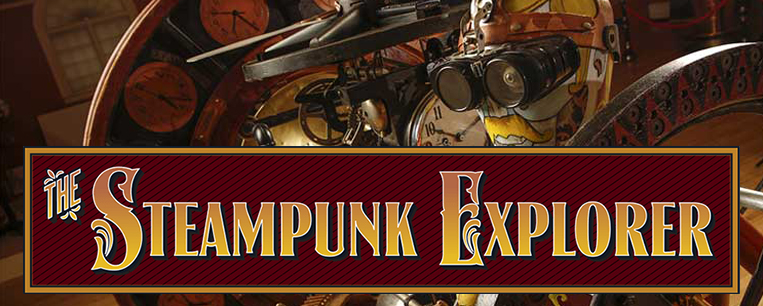

Bruce Rosenbaum discusses his past work, future plans, and thoughts on the creative process
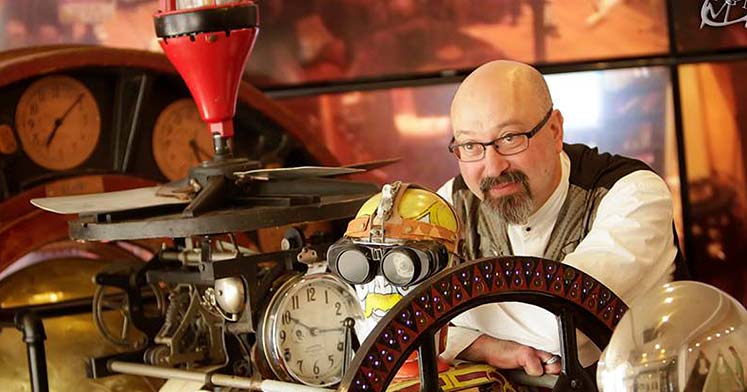
Photo: M.G. Norris Photography
Among the many artists and makers in the steampunk world, few (if any) have received as much media attention as Bruce Rosenbaum. His work has been featured in The New York Times, The Boston Globe, Chicago Tribune, CNN and many other outlets. He was described as the “Steampunk Guru” by the The Wall Street Journal and “Steampunk Evangelist” by Wired. More recently, he and his wife Melanie played prominent roles in an episode of Amazing Interiors, a reality TV show on Netflix.
We recently caught up with Bruce to discuss his past work, his future plans, and his thoughts on the creative process.
Steampunk Houses, Past and Present
His original claim to fame was the Steampunk House in Sharon, Massachusetts, about 50 miles south of Boston. After purchasing a 1901 Victorian Craftsman home in 2000, he and Melanie transformed it into a showcase for steampunk design. Antiques, such as an old stove, were retrofitted to function as modern electrical appliances. An ornate mantel became housing for a plasma TV. An antique printer’s bench became a kitchen counter. (See this story by steampunk artist Jake Von Slatt for a visual tour.)
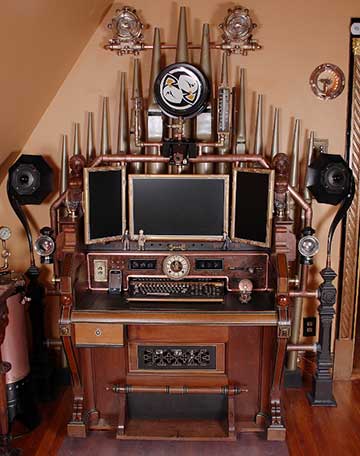

About five years ago, the Rosenbaums decided to sell the Steampunk House and find a new dwelling that would serve as a home, workshop, and art gallery. Sharon has one of the state’s best school systems, Rosenbaum says, but the town also has high tax rates. Their kids had grown up and moved out, “so it just didn’t make sense for us to continue to live there.” And “Melanie and I wanted to do an interesting adaptive reuse project. It could have been a bank or post office, even a barn.”
What they found was a Gothic church originally built in 1876 in Palmer, a town near Springfield in western Massachusetts. The 9000-square-foot building, on three-and-a-half acres, was selling for just $100,000. It was structurally sound, but required extensive restoration and abatement, including asbestos removal. They also had to obtain a special permit from the city to allow use of the building as a home and business.
The structure includes a 5,000-square-foot cathedral that functions as the gallery, plus a smaller living space slightly below ground level.
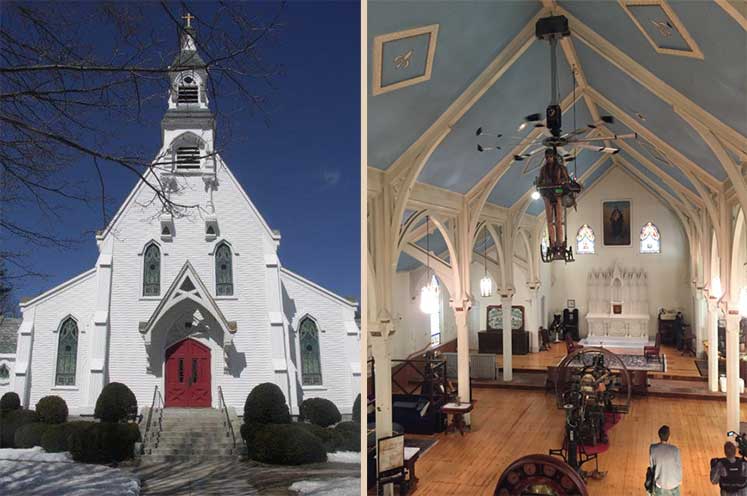

They closed the deal in February 2016 and moved in about six months later. Then they got a call from the producers of Amazing Interiors, a new reality show from Netflix focusing on unusual homes. The producers had read about the Steampunk House in Sharon and wanted to include it in the series. “I said, ‘Well, I’m sorry, but we moved out. We bought this incredible church property and we’re converting it into our home, gallery, and workshop space.’ And they said, ‘Even better.’”
Film crews visited three times between April and November 2017. Amazing Interiors debuted in July 2018, and the Rosenbaums’ “Steampunk Wonderland” can be seen in Episode 8, along with a “House of Dictators” in London and a home in Pennsylvania that occupies a former bank building. Their story is told in multiple segments during the half-hour episode.
In one segment, Bruce hunts for “raw materials” at the Brimfield Antique Show. Other scenes were shot inside and outside the church as the Rosenbaums worked on the restoration and prepared for a grand opening.
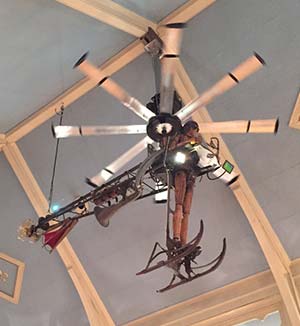

The signature project was “Helioman,” a nine-foot-tall figure with a rotor that functions as a fan. Rosenbaum describes it as a “Da Vinci-inspired flying machine.” To create the contraption, he led a team that included sculptor Michael Ulman and Big A## Fans, a manufacturer in Lexington, Kentucky. One theme that runs through the episode is Melanie’s concern about Helioman’s $15,000 price tag.
“Helioman” is an example of a “Humachine,”Rosenbaum’s term for sculptures that represent notable authors and inventors of the past.
The Netflix episode portrayed the house as a museum, but Rosenbaum says they don’t have regular business hours and they’re not yet ready to accept public visitors. The eventual goal is to host ticketed events once or twice a month where people can tour the gallery, and probably the living space as well. The events will also include lunch at Steaming Tender, a restaurant in Palmer within a former train station.
He expects to list the events in Airbnb’s Experiences section, and will notify folks who have signed up for his e-mail newsletter.
“Discover Steampunk”
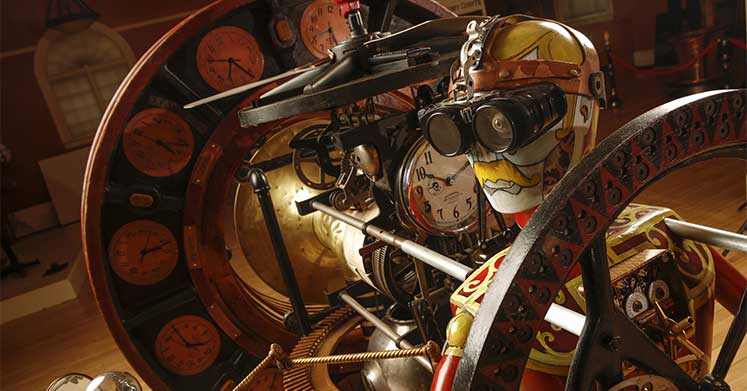

Some of the “Humachines” seen in the Netflix show became part of “Discover Steampunk,”an exhibit that ran from May 11, 2018 through January 6, 2019 at the Museum of Idaho in Idaho Falls.
The exhibit has seven galleries, three devoted to authors (Mary Shelley, Jules Verne, and H.G. Wells) and four to inventors (Isaac Singer, Thomas Blanchard, George Eastman, and Jan Matzeliger).
Rosenbaum conceived “Discover Steampunk” in collaboration with Imagine Exhibitions, a company that manages museum shows around the world. Originally planned as a traveling exhibit, it’s now in climate-controlled storage at a facility in Utah. Imagine is seeking new venues for the show, and museums in Australia, Poland, and England have expressed interest, Rosenbaum says. But at present, there are no signed contracts.
Commissioned works
Rosenbaum earns much of his income by offering steampunk art and design services to residential and business clients. He does this through ModVic (short for “Modern Victorian”), a company that he and Melanie launched in 2007. Recent projects include:


Steampunk Mechanical Whale. This interactive project was commissioned as part of a restoration of The Nantucket Hotel & Resort, a property originally built in 1891. It was the first of several collaborations with Salmon Studios of Florence, Massachusetts. Rosenbaum conceived a six-foot kinetic sculpture of a submarine in the shape of a whale. Built from wood, brass, steel and aluminum, it’s mounted behind the front desk in the lobby. Pressing a button in the reception area causes the mouth and tail to move.
Aquarium Beer Tank. Rosenbaum also collaborated with Salmon Studios to create this project for 10K Alley, a gastropub and gaming center at the JW Marriott Marco Island Beach Resort in Marco Island, Florida. Envisioned as a giant steampunk aquarium, the 20-foot-tall structure sits behind the bar, providing taps for 50 beers. It features six antique porthole window frames that will eventually incorporate LCD monitors that can play a single continuous video. The video could depict the interior of a beer fermentation tank or an underwater scene with aquatic creatures.
Cassandra Clare studio. Rosenbaum was commissioned to remodel a writer’s studio for Cassandra Clare, author of the popular Infernal Devices and Mortal Instruments fantasy series. “I did a whole floor in this steampunk retro-future aesthetic, based on some of her novels,” he explains. He assembled a large group of fabricators and engineers to work on the project, including kinetic artist Todd Cahill, metalworker Sam Ostroff, glass engraver Steve Schlosberg, seamstress Ruth Buffington, engineer Mark Dobrosielski, graphic designer Jim Bremer, restoration specialist Mark Peltier, and cabinet makers Dovi Hirsch and Efraim Shapiro.
The studio features a “Photo Booth Time Machine” made from a vintage British K2 phone booth. One side is painted with a green screen background, so guests’ photos can be instantly composited into scenes from the past, present, and future. The booth uses controls salvaged from an old elevator and paper mill. Guests can choose from 54 scenes.
You can view the project in this short video on YouTube. It also received prominent mention in an April 2016 profile of the author in The New York Times.
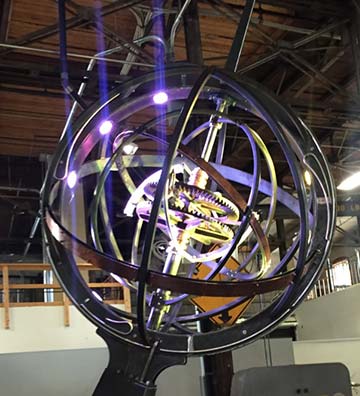

Pneuman. This project, designed for the Skeleton Key escape room in West Hartford, Connecticut, was inspired by 19th century pneumatic vacuum systems. Patrons in the waiting room can place written questions in a capsule. The message is whisked through a pneumatic tube to an unseen “Spirit World,” which sends a reply. One key component was an Addressograph dog tag machine. You can see it in this YouTube video.
Celeste Steampunk Armillary Sphere.Another collaboration with Salmon Studios, this 25-foot-tall kinetic sculpturedepicts celestial objects. They built it for the Kimpton Marlowe Hotel in Cambridge, Massachusetts.
“We incorporated an incredible planetary gear, a worm gear, from a 100-year-old mill, and made that the center of the sculpture,” Rosenbaum explains. “It represents the sun. We use modern materials — motors, LED lighting, and electronics that make it kinetic and interactive — but incorporate these beautiful gears that give you a sense of awe and wonder.”
The Creative Process
Celeste provides a good example of “Janusian Thinking,” a process that underlies much of Rosenbaum’s work. “It’s a kind of fusion of opposites, bringing two different ideas or solutions together and fusing them to create one robust solution,” he says. “That’s what we’re doing in steampunk design, combining the opposites of form and function, art and science, man and machine, past and present, that kind of thing.”
The process was first described by psychiatrist Albert Rothenberg, who conducted extensive research about creativity in art, science, and literature. The term is derived from the Roman god Janus, often depicted with two faces looking in opposite directions.
As he seeks more commission work, Rosenbaum is also encouraging potential clients to think about “‘hitmaking,’ in the sense of making something that people are willing to share. I’m reaching out to people in the corporate world, hospitality, restaurants, wineries, and breweries, to create a hit and to have a ‘Return on Novelty,’ as I call it, instead of ‘[Return on] Investment.’”
He sees hitmaking as a form of Janusian process that combines the familiar and the novel. “I think what makes a hit is that you kind of have familiarity with it. It’s in your wheelhouse. You kind of understand what’s going on here, but then there’s something you didn’t expect, that’s a little bit out of the ordinary. That’s what gets your attention.”
Steampunk Goes to School
Another recent initiative is “Steampunkinetics,” a program that uses steampunk art and design as an educational tool. In 2013, Rosenbaum collaborated with psychologist Ashleigh Hillier on a nine-week art and technology program for 15 young adults with autism. The participants used salvaged parts to build an elaborate Rube Goldberg contraption in which a pinball rolled through a series of tracks.
Hillier, a professor at the University of Massachusetts Lowell, published a case study of the project last year. It’s available as a PDF file.
Now Rosenbaum is seeking to expand the program to other groups that focus on Autism Spectrum Disorder. And he’d like to work with high schools, vocational schools and other places that are interested in using steampunk as part of STEAM (Science, Technology, Engineering, Art, Math) curricula.
Students could learn about a certain time period, read a science fiction novel about it, write their own stories, and conceive an invention “that would help save the world,” he says. “Then we design it and build it.” He welcomes inquiries from museums, schools, and other organizations.
If you’d like to meet the artist and learn more about his work, he’s planning appearances at the Watch City Steampunk Festival, May 11 in Waltham, Massachusetts, and the Railway to the Moon Steampunk Fest, Aug. 17-18 at the Mount Washington Cog Railway in New Hampshire.
Photos are used by permission of ModVic.
